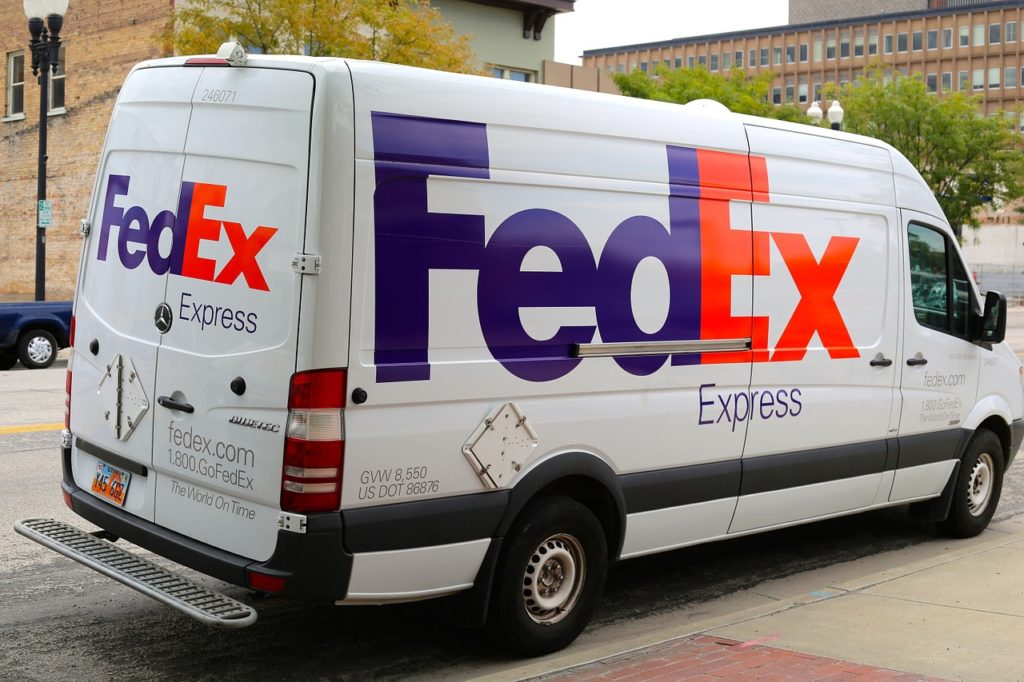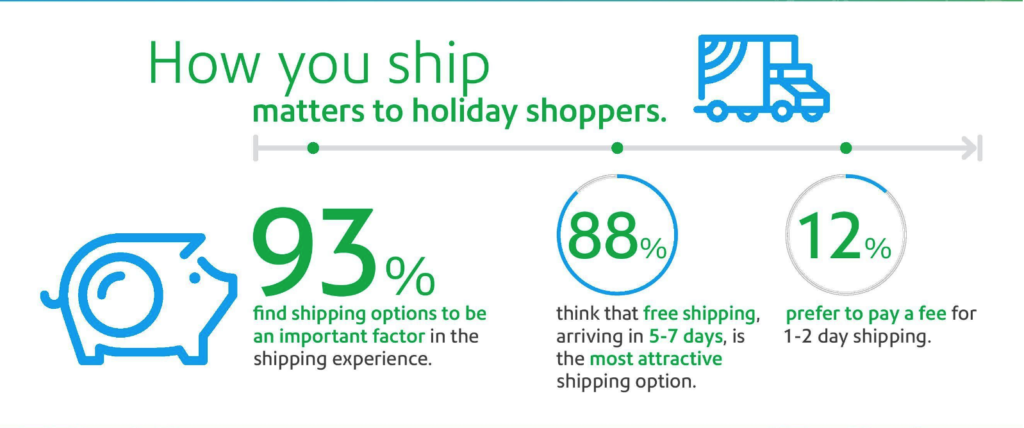With the holidays on the horizon, it’s time to test drive some scalable shipping strategies that are ready to deploy when the peak selling season — November and December — arrives.
There are many parts to a shipping strategy, like selecting a carrier and managing returns, but perhaps the most important of all is how you implement your shipping rates; the very thing impacting your bottom line.
The Power of Free Shipping
Look no further than Amazon Prime to understand how tantalizing free shipping can be to consumers. But let’s take the data a little further.
Last year, ecommerce postage provider Pitney Bowes released the results of their annual shipping survey, and not only did it reveal that a variety of shipping options matter, it suggested that free shipping remains the most attractive method of delivery for many consumers.
And it’s been this way for quite a while. As early as 2009 when ecommerce was beginning to truly ramp up, a UPS survey illustrated that shipping and handling costs were simply too high for consumers, with 44% of the nearly 3,000 respondents ranking it the highest concern when buying online. Costs either needed to be reduced or gotten rid of.
In many, many cases these days (thanks in part to Amazon), shipping is free for customers.
We could blabber about free shipping stats all day — needless to say it’s a big deal. But it presents just as big of an issue for many businesses: it means covering a cost that could significantly eat into margins.
Fortunately, consumers are willing to go through hoops to access that free shipping. Even if it means reducing the shipping costs for you.
UPS Pulse of the Online Shopper 2015
Many consumers are willing to wait longer for their package if it’s shipped free of charge, so if you’re absorbing the cost of shipping entirely, they’ll be cheaper.
Implementation
But what are the hoops a consumer might be willing to go through for free shipping? That depends on implementation. Free shipping can be put into action in various ways:
Thresholds — One of the more common methods of implementing free shipping, thresholds involve setting a minimum amount — it can be based on price or item count — that unlocks free shipping. The merchant markets the threshold around their website, a consumer’s cart meets the criteria, and the shipping fee is waived. Here’s how to go about enacting it:
- Set a baseline — First, set up an A/B test on your homepage; one page should have no threshold offered, and the another should market a threshold. After a period of time, compare the conversion rates of each page to gauge the threshold’s effectiveness.
- Develop thresholds — If the threshold is having an impact, start messing with the amount. Raise the threshold, whether it’s in regards to cart value or item count, and measure how conversions are affected.
- Divide and conquer — Begin identifying products where free shipping proves profitable or useful. For instance, if a product has high margins, slap free shipping on it to see if it increases demand. Or if a product doesn’t sell well, attach free shipping to it to see if it gets moving off the shelf. Afterwords, measure.
- Raise prices — After getting comfortable measuring the impact free shipping has on specific products, apply it to every product. Begin increasing the price of all products to account for the loss you’ll take by offering free shipping on each.
For even more, check out this awesome article on free shipping by Kissmetrics.
Every single order — The last two bullets above lead into this implementation: pure and simple, you can offer free shipping on every single order. It’s extremely marketable and straightforward, but you’ll need to be sure that you can afford it. That means checking the margins for your products, ensuring that they can absorb the cost. If they don’t, it might be time for a price increase. E-retailers with lightweight or high margin products are usually keen on utilizing this strategy.
Seasonality — Free shipping at it’s core is a marketing tool legendary for its conversion power, making the holidays a key time for launching the promotion. Consumers are already prepared to buy, and free shipping only encourages more sales. Other seasons are fair game as well, including those with weak demand. If it’s too expensive for you to offer free shipping year-round, launch it during select seasons with weaker performance to push order volume up.
Locational basis — Let’s say you’re based on the East Coast and plan to offer free shipping. A customer ordering from California is going to be ultra-expensive. Offering free shipping on a locational basis saves costs by letting you be picky about which customers get it. Some sales channels allow a merchant to set up specific shipping zones around their place of fulfillment so that when a customer within a certain zone orders, they’ll have access to full shipping. But that one customer way out of range won’t.
On abandonment — I’m sure you’ve experienced those triggered pop ups that pop up when you move your mouse away from a page. That’s the essence of implementing free shipping on abandonment; whenever a customer is on the checkout page, sees that shipping cost, and the cursor moves toward a red X, merchants can set up pop ups that offer something like a discount code for free shipping. Ideally, it’ll prevent them from abandoning and encourage them to cross the finish line. Here are some useful apps that work on a variety of shopping carts:
Returns only — Offering free shipping on returns only is a tactic that acts as both a motivational and preventative measure. Securing the consumer’s trust can be difficult when selling online, but free shipping on returns motivates them to trust a merchant by guaranteeing no cost on a dud of an order. On the other hand, after you’ve secured yourself a customer, you want them to keep on buying. If they are dissatisfied with an order, the free return ideally keeps you in their good graces so they continue working with you.
The Give or Take Rate
Free shipping can get pricey. If your margins can’t account for it and a price increase negatively impacts demand, flat-rate shipping is on the table. It’s just as it sounds; you’ll determine a shipping rate that’s attached to every single order, no matter the size.
To find the flat rate, determine the cost to ship each of your products and average them. That averaged cost should, give or take, be affordable. Because it’s an average, you’ll be spending a little more to ship some orders, and a little less on others.
But because shipping costs are determined by weight and size, that average might be inaccurate in the case of a diverse product catalog. If you’ve got small, lightweight products alongside larger, heavier ones, an averaged flat rate could be unworkable in terms of your margins.
To solve that, it’s possible to determine a flat rate based on weight range or order total range. As is the case for free shipping, test your flat rate to ensure it’s working at the bottom line, and adjust it if needed.
The good part about flat-rate shipping is that it’s upfront and marketable like free shipping. Instead of shocking the customer at the last minute as they make it to checkout, a flat-rate of $XYZ can be plastered all over your website, from banners to product copy.
Carriers Care
USPS and FedEx are also pretty helpful in the situation of flat rates. Rather than doing the math to determine your average rate, a merchant can select a flat rate box. If the order fits in the box, it ships anywhere at a flat rate. For merchants dealing with very similar products, even heavy ones, this allows them to offer a flat rate across the board because every product fits in the same box size with a flat rate.
Just like before, the catch with these boxes is the fact that sometimes a merchant’s product catalog is too complex. A catalog of products ranging from small to large creates complications since a merchant’s unable to pick a single box that can handle every product.
The Straightforwardness of Per-Order Rates
At times, covering any amount of shipping costs might have too much of an impact on margins. Like it or not, the customer is going to pay for however much it costs to ship a product.
It’s perfectly within a merchant’s means to calculate shipping rates and spit them out straightforward at the checkout page. It can be done in a few ways:
- Price-based — The merchant determines a shipping cost that’s affordable and varies based on the price of a customer’s order.
- Weight-based — How heavy the product is significantly impacts cost to ship, so merchants often base rates on weight. When a customer checks out, order weight is determined by the products, and an appropriate shipping rate is assigned.
- Real-time — Rates are automatically determined by the order and customer’s address. When a customer makes an order, a merchant’s carts or marketplaces take the products’ weights, the merchant’s fulfillment location, the ship-to address, and connect to shipping providers that calculate real-time rates.
In any case, the rate a consumer will pay is determined at checkout. While it’s advantageous for merchants because they obviously won’t be forking over the cash for shipping, the fear is that that extra charge will spook a customer at checkout, leading to an abandoned cart.
The best way to counter this is to create an offer on the product that the customer simply can’t refuse. If free shipping or discounted shipping is not an option, develop a promotion that will do the job instead. UPS’ 2015 survey seemed to suggest that a majority of consumers — 57% — are willing to pay the shipping cost so long as they’re getting a deal on the product. Makes sense; at the end of the day, the consumer is interested in getting a bargain, regardless of whether it’s due to the price of the product or lack of shipping costs.
Test Driving
Now is the time to roll out your shipping strategy. If you’re experimenting with free shipping, flat rates, or how your customers react to per-order rates, begin testing now in advance of the holidays so you’re prepared when the real avalanche of orders arrives.
Second Image: Flickr, marc falardeau






